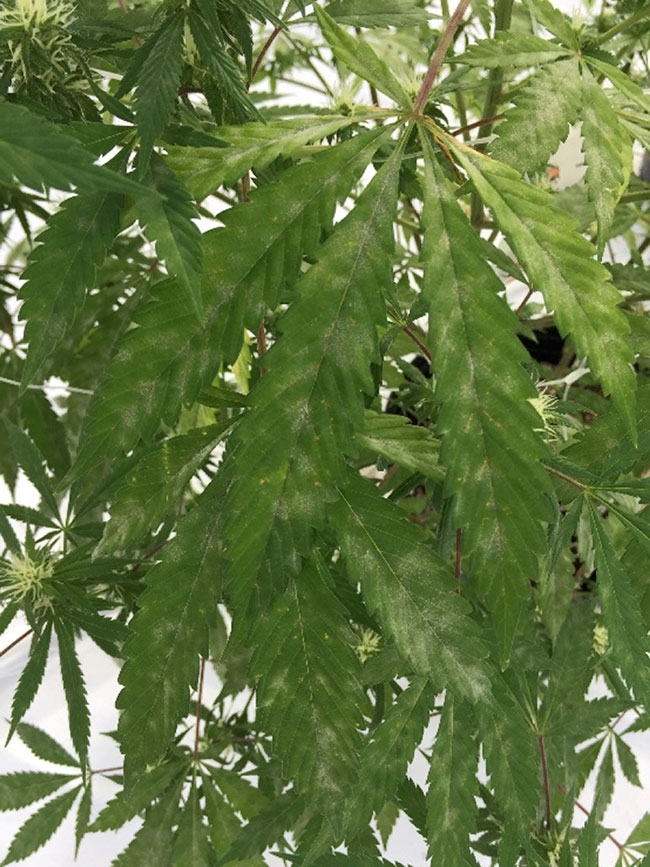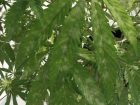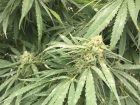
Features
Production
Minding mildew
While cannabis has no shortage of pests and diseases to challenge producers working within Health Canada’s guidelines, none has been more front and center than powdery mildew, which has dominated industry news both in terms of contamination of end-product by the mildew itself or illegal fungicides used to treat it.
May 28, 2018 By Kevin Cullum
 Cannabis producers in North America typically deal with two common mildew strain: the Leveillula taurica and the Sphaerotheca maculari. While cannabis has no shortage of pests and diseases to challenge producers working within Health Canada’s guidelines
Cannabis producers in North America typically deal with two common mildew strain: the Leveillula taurica and the Sphaerotheca maculari. While cannabis has no shortage of pests and diseases to challenge producers working within Health Canada’s guidelinesPowdery mildew is a disease that poses a huge challenge to many cultivated crops and this is only amplified in cannabis, which is limited by far fewer control options, less breeding for resistance to the disease and way lower microbial tolerances than any other crop. Many licensed providers currently rely entirely on irradiation treatments or processing into extracts to bring their end-product within Health Canada microbial specifications.
While the science is still somewhat speculative it appears North American cannabis producers are dealing with two or more strains of powdery mildew: Leveillula taurica, which is a common mildew strain on greenhouse peppers in Canada, and Sphaerotheca maculari, common in cannabis’s closest relative hops and possibly something closely related to S.macularis that is specific to cannabis.
To understand the reason’s powdery mildew presents such a challenge to control, it is necessary to understand a couple of important points about its biology. Most important being the haustorium, which is a hyphal thread that emerges from the mildew spore penetrating into the plant tissue through an open stomata where it acts similar to a plant’s root system, anchoring the mildew to the plant while providing nutrition by breaking down plant tissue to feed the portion of the fungus growing on the leaf surface. It is important to understand haustorium because it lives within the plant, while all of the fungicide products registered in Canada for cannabis only control the surface portion of the mildew and have minimal to no effect on haustoria.
Looking to conventionally grown non-cannabis crops, powdery mildew is always controlled by a combination of systemic fungicides (i.e. Myclobutanil) to target the haustoria with more foliar active products like the ones registered for cannabis targeting surface hyphae and spores. Without having any registered products for cannabis that act systemically, it is essentially impossible to eradicate mildew from the facility once established by means of spraying. In other crops facing similar situations, such as organically grown cucumbers or grapes, growers accept that they will have a level of mildew present in the plants. In cannabis, however, this would mean a failed microbial test – so it is not usually an option. Although we have many tools to utilize in an integrated pest management program for powdery mildew, the most viable one by a long shot is prevention.
Genetic culprits
Cannabis cultivars vary widely in their resistance to powdery mildew, largely steered by the original source population(s) they were derived from. Much of the mildew problems growers face today is due to the predominance of genetics derived from Afghan/Pakistani gene pools. Plants from these areas tend to have little genetic resistance to powdery mildew as the very arid conditions they evolved in had little disease pressure.
Early drug cultivar breeders focused on plants from these areas largely due to quick maturation time, dense bud structure and increased photosynthetic efficiency (from higher chlorophyll levels). However, in bringing these genes into seed lines they also brought along an extreme susceptibility to powdery mildew. Plant populations derived from areas with higher disease pressure, such as tropical and sub-tropical locations like Colombia or Thailand, tend to have much higher resistance to diseases like powdery mildew. Partially, this is due to their more open bud structures which shed water and condensation quicker, minimizing environments conducive to spore germination. More so, it is due to the plant’s ability to mitigate attack by the pathogen on a physical and/or chemical level.
Several plant traits of resistance to powdery mildew are known; ranging from exclusion where the plant stomata are too small for the haustorium to penetrate to an ability to build denser cell walls in the area surrounding where the haustorium has penetrated preventing further growth. Plant manufactured terpenes or other compounds with fungicidal action may also play a role. Ideally, a combination of these should be stacked into a cultivar to provide multiple layers of horizontal resistance so that if the pathogen evolves to overcome one resistance mechanism it is met by several more.
It may be necessary to go back to landrace NLD cultivars to acquire novel resistant genes to be incorporated into modern, market-driven varieties lacking these traits.
Control options
Mildew can come from many sources: clones contaminated by spores or haustoria brought in from other producers, spores carried into facilities from outside by air currents or workers with infected plants at home bringing spores in on their clothing. Potential transmission can be minimized from workers by requiring protective coveralls and shoe covers be worn in the facilities. However, “minimizing” is the key word as eliminating this avenue of entry completely is not a viable option. Influx from air currents can be filtered by hepa and carbon scrubbers in indoor facilities, but this far from eliminates the possibility and in most greenhouse designs this is not a viable option.
The variable most easily controlled is probably also the most common method of entry for powdery mildew into and within a production facility: infected clones brought in from outside sources. Preferably, incoming plant material should be limited to new mother stock only. Using outside propagators is opening your facility to a huge risk factor outside of your control. Incoming plants should ideally be brought in only as unrooted cuttings and sprayed or dipped with a registered fungicide immediately on arrival to treat for surface spore or fungal material. They must then be kept in a quarantine room until certain they are not infected before being added to mother plant stock.
To take the guesswork out of whether your facility has undetected powdery mildew present, regular DNA sequence tests can be done on all mother stock with any positive plants culled. Ensure production plants can be traced back to the specific mother so that in the event an infected mother is discovered, any production clones sourced from it can be culled as well.
Many growers base the majority of their powdery mildew control strategy around keeping a good climate. While this for sure should be a primary strategy, the spores of some mildew strains are able to germinate well within the best relative humidity control regimes. In greenhouses, it is often not possible to keep crops within ideal humidity ranges all the time. While environment is a key factor in managing disease, it is not one that can be relied solely upon in the case of powdery mildew. It needs to be integrated with other control measures.
Canopy management can be a key tool in mildew control. Large, dense buds may look impressive but they create a very uneven micro climate, trapping moisture both from transpiration and condensation inside. This type of bud structure is another trait selected from arid climate-adapted Afghan/Pakistani strains, and is uncommon elsewhere in the world where cannabis has evolved as it makes them very prone to disease.
Increasing the number of cola stems per square meter will make a much more disease-resistant canopy due to higher airflow through the buds and minimizing humidity differences caused by decreased airflow in larger buds. Any foliage or buds in areas of the canopy that are not getting sufficient light for saleable bud formation should be removed. Plant tissue from these areas is much more susceptible to powdery mildew attack as it tends to be softer tissue higher in nitrogen levels, both of which are conducive to the disease.
Fungicides
None of the fungicides currently registered for cannabis in Canada will eradicate powdery mildew and should be viewed only as suppressant in effect. While most are very effective against mildew, they only act on the surface portion and, in some cases, the spore. As none of these products will kill the haustoria, a spray program is limited to reducing spore count and killing surface area mildew for the period the spray is active, which is usually less than a week. Modes of action for these products primarily fall into one or more of several categories:
Sporicidal – either kills spore by desiccation or prevents from germinating. Extremely important tool in the event mildew has sporulated in the greenhouse.
Induced Systemic Resistance (ISR) – many bacteria or fungal strains present as active ingredients in bio-pesticides or plant stimulants to trigger the plant’s immune system heightening its protective measures against disease attack. Though the science is still out on exact modes of actions, some examples include cell wall thickening and a quickened stomata closure response to stop fungal penetration.
Antibiotic – fungal and bacterial based bio-pesticides produce a large array of antibiotics in their exudates that have multiple modes of action and strong fungicidal effect. Many bio fungicides have large amounts of these antibiotic exudates present in the bottle from the production process and these are the primary modes of fungicidal action.
Leaf surface PH – A key mode of action of potassium-bicarbonate-based products is the raising of the leaf surface pH above tolerable levels for powdery mildew. Other products may also follow this same mode of action.
Oxidizer – Some bio fungicide products work as oxidizing agents similar to how hydrogen peroxide works.
Sulphur – Sulphur’s mode of action remains unclear but acts in multiple modes of action on varying life stages of powdery mildew. Caution needs to be taken with sulphur as excess use can completely disrupt biological control programs as well as build up in the resins affecting end flavor of the product especially when concentrated into extracts.
A common myth when it comes to bio fungicides is that the organism can live on the leaf surface outcompeting the pathogen for food and/or directly attacking it. Any of the products currently on the market are all based on soil microbes. While they can persist for long periods in the root zone on the leaf surface they last very short periods of time, which is why they need to be re-applied frequently.
Plant nutrition
Once established in a plant, powdery mildew can remain invisible to the naked eye until a stress event triggers spore production. Release of spores in a greenhouse or grow room escalates from what may be a single infected plant to a wide-scale infestation with potential for the spores to travel into adjoining areas and subsequent crops. All avenues to avoid this should be taken.
One of the most common stress events leading to mildew sporulation outbreaks occurs as the plant hits peak flower (typically week 5 or 6 in an 8-week strain). The plant’s nutrient demand is at its highest and the plant is often stressed by minor nutrient deficiencies and used up carbohydrate reserves. Mildew can spread quickly in these conditions and the combination of dense bud structure and senescing plant tissue provide a beneficial environment for the mildew to take hold. Anything that can be done to keep plants at peak health during this stage is highly beneficial from a mildew resistance standpoint.
While most growers have the climate portion of the equation well dialed in during this stage, the root zone is often not optimized for this peak nutrient-demand period. Utilizing a wide scope of chelates, including the more expensive ones such as EDDHA, DTPA, fulvics and amino chelates, help minimize nutrition problems during this period of peak demand. Many plant-growth-promoting bacteria and fungi products are also proven to enhance a plant’s nutrient uptake, both by the action of natural chelates produced in the form of exudates as well as from the direct action of fungal threads acting as extensions of the roots better extracting available ions for the roots and breaking down insoluble nutrients into ions suitable for plant uptake. Incorporating silicon, higher calcium levels as well as avoiding excesses of nitrogen are all well proven methods for strengthening plants against powdery mildew attack.
Though an integrated approach to controlling powdery mildew will always be necessary for cannabis grown to meet the residual and microbial standards of Health Canada, developing genetically resistant cultivars, regular DNA testing, and roguing of mildew-infected plants remain the most effective and practical strategies to address this growing challenge.
Kevin Cullum is the Canadian technical manager for Koppert Biological Systems (www.koppert.ca). Koppert is a producer of beneficial insects, bacteria and fungi, and provides integrated pest management consultation to growers worldwide.
Print this page

